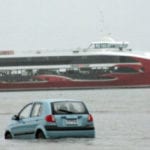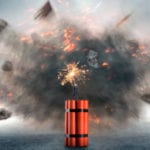 Miscellaneous
Miscellaneous  Miscellaneous
Miscellaneous  Our World
Our World 10 Green Practices That Actually Make a Difference
 Humans
Humans Ten Historic Men Who Deserve Way More Credit Than They Got
 Movies and TV
Movies and TV The 10 Most Heartwarming Moments in Pixar Films
 Travel
Travel Top 10 Religious Architectural Marvels
 Creepy
Creepy 10 Haunted Places in Alabama
 History
History Top 10 Tragic Facts about England’s 9 Days Queen
 Food
Food 10 Weird Foods Inspired by Your Favorite Movies
 Religion
Religion 10 Mind-Blowing Claims and Messages Hidden in the Bible Code
 Facts
Facts 10 Things You Never Knew about the History of Gambling
 Miscellaneous
Miscellaneous Ten Groundbreaking Tattoos with Fascinating Backstories
 Our World
Our World 10 Green Practices That Actually Make a Difference
 Humans
Humans Ten Historic Men Who Deserve Way More Credit Than They Got
Who's Behind Listverse?

Jamie Frater
Head Editor
Jamie founded Listverse due to an insatiable desire to share fascinating, obscure, and bizarre facts. He has been a guest speaker on numerous national radio and television stations and is a five time published author.
More About Us Movies and TV
Movies and TV The 10 Most Heartwarming Moments in Pixar Films
 Travel
Travel Top 10 Religious Architectural Marvels
 Creepy
Creepy 10 Haunted Places in Alabama
 History
History Top 10 Tragic Facts about England’s 9 Days Queen
 Food
Food 10 Weird Foods Inspired by Your Favorite Movies
 Religion
Religion 10 Mind-Blowing Claims and Messages Hidden in the Bible Code
 Facts
Facts 10 Things You Never Knew about the History of Gambling
Top 10 Natural Disasters And Their Historical Consequences
Natural disasters have changed the course of human history. Although not everyone agrees on their effects, the links between these events and the social and economic changes afterward are intriguing.
Natural disasters have led to some of our greatest innovations, to periods of civil war and political unrest, to the destruction and creation of empires, to massive human migrations and clashes of cultures, and ultimately, to the world we know today.
10 The Toba Supervolcanic Eruption
Circa 75,000 Years Ago
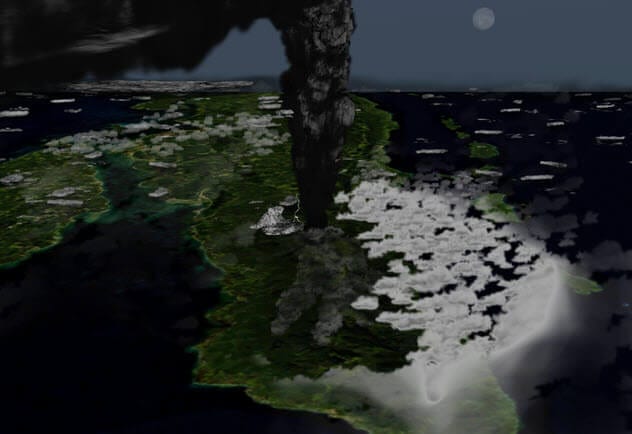
Lake Toba in Indonesia is home to a supervolcano that erupted some 75,000 years ago. It has been linked to a population bottleneck within our ancestors’ past. The event was by far the largest supervolcanic event in recent geologic history and attained a Volcanic Explosivity Index (VEI) rating of 8, the maximum possible on this scale. It pushed an estimated 2,800 cubic kilometers (670 mi3) of dust and rock into the atmosphere.
The Lake Toba Theory holds that the event coincided with the last major glacial period, which ended some 5,000 years ago, and the event itself led to a 1,000-year-long global cooling event. This may have contributed to or accelerated the planet’s entrance into the last ice age.
A genetic bottleneck in human DNA occurred around the same time as the eruption. According to the theory, the human breeding population fell to between 3,000 and 10,000 individuals around 50,000 to 100,000 years ago. The link to Toba is that 70,000 years ago, there were 1,000–10,000 breeding pairs, a very small population of humans who created this genetic bottleneck. As a result, human DNA has one of the lowest proportions of genetic diversity, which is why racism is such a fallacy based on this fact alone.
The Toba eruption would have caused worldwide global ecological disaster, devastating vegetation and the global food chain dependent on it. Bottlenecks have also been observed in other primate groups around this time, including chimps, gorillas, and orangutans as well as in macaques, tigers, and cheetahs.
The timing of the eruption is also closely linked to the migration of early humans from Africa 60,000–70,000 years ago and is quite possibly the disaster that started our epic journey.[1]
9 The Minoan Eruption
Circa 1500 BC
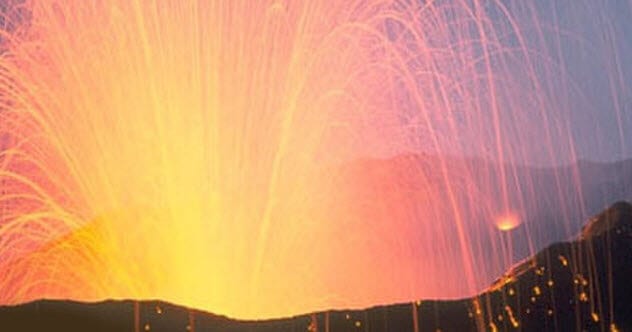
The Minoan eruption (aka the Thera or Santorini eruption) occurred approximately 3,500 years ago and devastated the Minoan civilization and the Mediterranean cultures of the time. The eruption was between 6 and 7 on the VEI, pushing some 60 cubic kilometers (14 mi3) of dust and rock into the atmosphere.
The volcanic explosion and resulting tsunamis wiped out many communities in Akrotiri, Crete (Minoan), Cyprus, Canaan, ancient Greece, Egypt, and most areas of the Aegean Sea. The resulting devastation allowed the Mycenaean civilization to take over the Minoan culture and blend it with their own.[2]
This formed the first advanced civilization in mainland Greece, with its palatial states, urban organization, works of art, and writing system. It also heralded the first steps toward our modern cultures and the development of Koine Greek, the language of the original Bible.
At the time, the event itself had worldwide repercussions. In China, the volcanic winter effect of the Thera eruption corresponds to the collapse of the Xia dynasty, thus allowing the Shang dynasty to rise. The Bamboo Annals describe the time as “yellow fog, a dim Sun, then three Suns, frost in July, famine, and the withering of all five cereals.”
In Egypt, there is evidence to suggest that the calamity heralded the end of the Second Intermediate Period. Apocalyptic storms, climatic change, and tsunamis were the gods’ way of showing displeasure with this period, resulting in the New Kingdom period and ancient Egypt’s most prosperous time as well as the peak of its power.
8 The Bhola Cyclone
1970

The Bhola cyclone struck the coast of Bengal in 1970 in an area then known as East Pakistan. Today, we know that area as Bangladesh. The storm was responsible for over 500,000 deaths, with most from a storm surge that inundated the low-lying islands of the Ganges peninsula.[3]
At the time, Pakistan was ruled by a military junta headed by General Yahya Khan. Their response to this disaster was utterly disorganized, and many thousands died needlessly while awaiting relief operations. Unfortunately for the junta, an election had already been called for just a month after the event took place. This resulted in an overwhelming landslide victory in East Pakistan for the Awami League.
During the months that followed, continuous civil unrest and distrust between an already marginalized East Pakistan and the central government resulted in one of the worst periods in modern world politics. The Bangladesh Liberation War broke out, later developing into the Indo-Pakistani War of 1971.
This led to multiple heinous atrocities, resulting in the Bangladesh Genocide of 1971. Sadly, 30 million people became displaced and three million people died. Pakistani soldiers raped between 200,000 and 400,000 Bangladeshi women. Compare this to the modern-day exodus of five million from the Middle East because of Islamic fundamentalism, and it puts the current situation neatly in context.
The Bangladeshi Liberation War was also fought as part of the larger Cold War. The superpowers fought over ideology within the region, exacerbating the problem for political gain and proof of their ideologies. The US supported its old ally Pakistan, no matter the atrocities they committed, and the Soviet Union supported India and Bangladesh.
It was all ended by George Harrison and Ravi Shankar with The Concert for Bangladesh in 1971. No, not really, this is sarcasm. Megastars have zero power in conflict, but this was the first major global superstar event of its kind.
7 The Black Death
1346–1353

The Black Death, a pandemic caused by the Yersinia pestis bacterium, devastated Eurasia in the mid-14th century. The plague was responsible for the deaths of up to 60 percent of the population of Europe and Asia during this period, which means that 75–200 million people perished.
The plague is thought to have originated in the Central Asian plains. It was transported to Europe via the Silk Road to Crimea and then spread by Oriental rat fleas infesting the black rats that were regular stowaways on merchant ships. This exploitation of economic trade routes made the plague difficult to eradicate, and there were several instances of localized reemergences over the following five centuries.[4]
It also created social upheaval with renewed vigor within the Christian church. Several groups were demonized and held responsible for the Black Death, including Jews, beggars, lepers, foreigners, friars, pilgrims, and Romani. Those with skin diseases, such as lepers, were singled out and exterminated by the vengeful.
In particular, Jews were persecuted as they were thought to be the vector. The rumor of Jews poisoning wells was heard throughout Europe. In February 1349, 2,000 Jews were executed in Strasbourg alone by a vengeful populace. Many Jews in Cologne and at least 200 other Jewish communities were destroyed as part of these purges, which were sanctioned by those caught up in this new religious fervor and by a Christian church that did nothing to stop these atrocities.
This is remarkably similar to where we find ourselves today by demonizing a whole religion as a means to an end.
6 The Kuwae Eruption
1452–1453
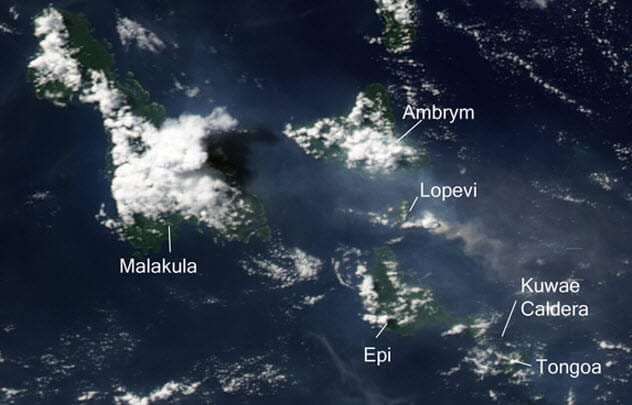
Kuwae is an undersea volcano and caldera in Vanuatu. It is one of the most active volcanic regions in the world, with many undersea eruptions. Sometimes, they break the surface and leave behind small islands that slowly sink beneath the waves. For example, the eruption of 1901 left an island that was 1 kilometer (0.6 mi) long and 15 meters (50 ft) above sea level. It had sunk back beneath the waves within six months of surfacing.
The giant eruption of 1452–1453 destroyed the island of Kuwae, leaving behind two smaller islands named Tongoa and Epi with a 12-kilometer (7 mi) by 6-kilometer (4 mi) caldera between them. The caldera has frequent volcanic activity.[5]
The eruption released some 39 cubic kilometers (9 mi3) of ash and dust, and the island collapsed to a depth of 1,100 meters (3,600 ft) below sea level. One of the largest volcanic events in the last 10,000 years, it was six times larger than Mount Pinatubo event of 1991 in the Philippines.
The eruption is linked to the second pulse of the Little Ice Age and was felt around the world with climate cooling. This is suggested by modern tree rings, Greenland ice cores, and the many crop failures around the world that were noted in the written history of the time.
Chinese writers of the Ming dynasty named the date specifically and wrote about “nonstop snow damaged wheat crops.” Later, as dust blotted out the sunlight, they wrote, “Several feet of snow fell in six provinces; tens of thousands of people froze to death.” There are more references to long periods of heavy snowfall, icebound seas, and the many people who succumbed to hunger and cold.
But its biggest victim may well have been the Byzantine Empire via the fall of Constantinople.
Under the leadership of Sultan Mehmed II, the Ottoman Turks invaded Constantinople on April 5, 1453, and conquered it on May 29, 1453. Historical accounts of the city at that time mention the volcanic aftereffects, including a thick fog in May that was otherwise unheard of, severe thunderstorms, a daytime red sky, and numerous floods.
People outside the city thought it was on fire. According to historians, “Flames engulfed the dome of the Hagia Sophia, and lights, too, could be seen from the walls, glimmering in the distant countryside far behind the Turkish camp (to the west).” But this was actually a reflection from the deeply red volcanic ash clouds in the atmosphere.
The siege could have been held if not for the failure of crops during the growing season prior to the sultan arriving at the gates. The crop failures and poor harvest, directly related to the volcanic winter, allowed the siege to be over in weeks rather than months. This destroyed the Byzantine Empire and permitted the Ottoman Empire to flourish.
All because of a now-nonexistent island in the Pacific Ocean, the emigres from Constantinople (refugees and economic migrants)—including the writers, musicians, astronomers, architects, artists, philosophers, scientists, politicians, theologians, and more—brought to Western Europe the far greater preserved and accumulated knowledge of their civilization, enriching our own.
5 The Tangshan Earthquake
1976
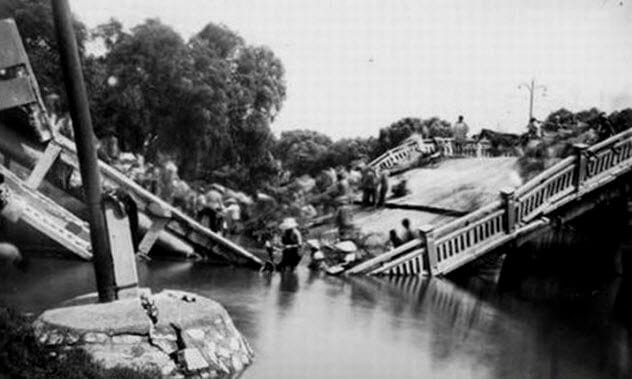
The Tangshan earthquake of July 28, 1976, was the third-deadliest earthquake in human history. Officially, 240,000–255,000 people were killed in the event. However, it is far more likely that 600,000–700,000 people perished in the earthquake.
The area is a densely populated industrial hub within China, and there were many warning signs prior to the event itself. Wang Chengmin, a State Seismological Bureau scientist, had predicted the earthquake with surprising accuracy, stating that it would happen between July 22 and August 5, 1976.[6]
In China, large earthquakes are seen as preceding great dynastic change, and this event may have triggered the greatest change in Chinese history. At the time, the Gang of Four—Mao Tse-tung’s last wife, Jiang Qing, Zhang Chunqiao, Yao Wenyuan, and Wang Hongwen—were the leaders of the Chinese Communist Party. However, no one can agree if they were acting alone or on Mao Tse-tung’s official orders. As the de facto leaders of the Cultural Revolution, they were responsible for some of the worst excesses and atrocities of that period in Chinese history, leading to stagnation politically and economically.
Deng Xiaoping had already risen to significant influence in Chinese politics. However, his policies of economic reform following the Great Leap Forward had seen him removed from office twice by Mao and his chosen successor, Hua Guofeng.
Deng was vilified in the press during the earthquake’s aftermath with various slogans and sound bites such as: “There were merely several hundred thousand deaths. So what? Denouncing Deng Xiaoping concerns 800 million people” and “Be alert to Deng Xiaoping’s criminal attempt to exploit earthquake phobia to suppress revolution!”
Mao Tse-tung died in September 1976. In traditional Chinese minds, the earthquake had heralded a new dynasty, which would be under Deng Xiaoping and his pragmatic “Socialism with Chinese Characteristics” slogan. This process has raised China from an agrarian farming society under Mao with one-sixth of the world’s population and less than 5 percent of world GDP in 1976 to second place in 2016 with 15 percent of world GDP. China will likely pull ahead of the US by 2025.
Deng Xiaoping was never the actual leader of the Chinese Communist Party or even China itself. He worked his political ideology through his careful social, political, and economic maneuvering. Deng built China into the powerhouse we know today and became known as the “architect of modern China.”
4 The Eruption Of Mount Tambora
1815
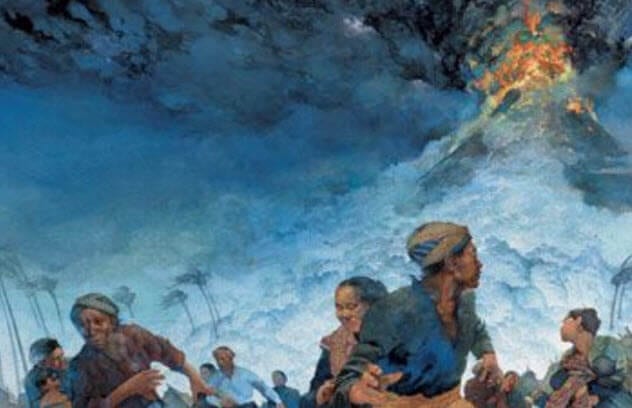
The 1815 eruption of Mount Tambora is the largest eruption in modern history with a VEI rating of 7. It had a massive impact worldwide with what became known as the “year without a summer.”
This event is also the last pulse of what has been termed the Little Ice Age, a period of increased volcanism, decreased solar activity, and reduced human interaction with our climate. There were three distinct pulses during this period, with the Kuwae eruption above as the second such period of increased climate instability.
From 1808 to 1815, there were several significant volcanic eruptions, with Tambora being the latest and largest. There was a mystery VEI 6 eruption in 1808–09 (unknown origin), the La Soufriere eruption of 1812 (Saint Vincent), the Mount Awu eruption of 1812 (Indonesia), the Suwanosejima eruption of 1813 (Japan), and the Mount Mayon eruption of 1814 (Philippines). These combined events made the 1810s the coldest decade of the last 500 years.
The ash cloud generated by the Tambora eruption significantly blocked solar radiation, leading to very late frosts and widespread crop failures that were well-documented in Europe, America, and China.[7] This led to widespread price hikes of up to four times the previous year’s cost, resulting in rioting, looting, and civil unrest throughout Europe.
In addition, there were huge storms, floods, and abnormal frosts throughout many parts of the world. The effects were particularly felt in Europe, with many social policies and rights being sought directly after this period. In the years following the eruption, there was also a significant increase in typhus and cholera in Europe and India.
Culturally, the paintings of J.M.W. Turner specifically show the red sky as spectacular sunsets. The lack of a feedstock for horses and other beasts of burden may have been the jolt needed for Karl Drais to invent his velocipede, the precursor to modern mechanized transport.
These eruptions may have also triggered the settlement of the American heartland as settlers relocated from New England due to the crop failures, and it was possibly the first era of the antislavery movement. Mary Shelley wrote Frankenstein, Byron wrote “Darkness,” and Polidori wrote “The Vampyre,” all while staying in Villa Diodati, shaping much of modern fantasy literature.
Mineral fertilizers were created as a direct result of this worldwide famine. Justus Freiherr von Liebig, a German chemist, remembered his childhood during the famine period and subsequently became known as the “father of modern fertilizer.” He also invented Oxo.
3 The Laki Eruption
1783–1784
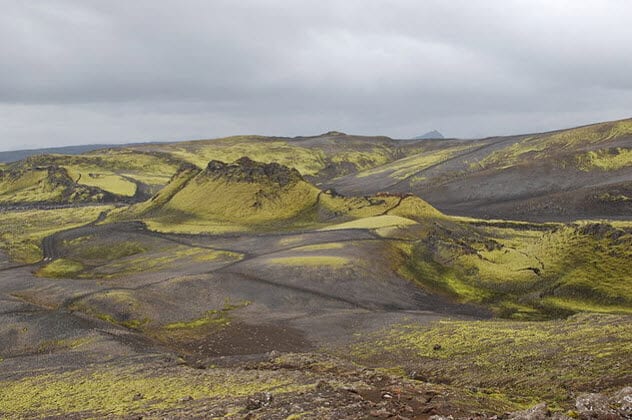
The Laki fissure volcano in Iceland is a 25-kilometer-long (16 mi) rent in the Earth with 130 volcanic vents along its course. It erupted through this fissure during 1783–84 with a VEI of 6. Approximately 14 cubic kilometers (3 mi3) of basalt lava spewed out, along with poisonous clouds of sulfur dioxide compounds and hydrofluoric acid that spread throughout the world.
This caused acid rain over much of Europe as well as dust across the world that blocked the Sun and lowered global temperatures. The result was widespread famine, disease, and death. This occurred not many years after the previous Lisbon quake (discussed below) had already seeded the questioning of authority.
The effect in Iceland was to cause the deaths of 25 percent of the population, 50 percent of livestock, and most of that year’s crops.[8] Lava fountains from the eruption sometimes reached 1,400 meters (4,600 ft) in the air. This is almost five times as high as the reach of Hawaii’s famous lava fountains, giving an indication of the size of this event over a length of 25 kilometers (16 mi).
The total eruption released approximately 8 million tons of hydrogen fluoride and 120 million tons of sulfur dioxide, which was later called the “Laki haze” throughout Europe. These gases and dust caused weakened monsoons in Africa and India and led to the deaths of about one-sixth of Egypt’s population during a famine in 1784.
Across the whole of Europe, crops failed. The sulfur dioxide in the air caused severe respiratory illnesses, with an estimated death toll of over 23,000 in Britain alone.
In America, the coldest and longest winter ever recorded even delayed the end of the American Revolutionary War by preventing Congressmen from getting to Annapolis on time to vote for the Treaty of Paris. Famine and disease spread throughout Europe, and the recovery lasted nearly a decade.
When confronted by a starving populace in France, Marie Antoinette is supposed to have exclaimed, “Let them eat cake.” France was already in perilous shape after the Seven Years’ War. Then the American Revolutionary War put the country in severe debt, resulting in social unrest and highly unpopular tax initiatives. The famine caused by the Laki eruption, along with these unpopular taxes and the effects of the Enlightenment, set the wheels in motion for the French Revolution.
One of the most important events in human history was partially caused by a volcanic disaster in Iceland. It triggered the global decline of absolute monarchies while replacing them with republics and liberal democracies.
It also inspired liberal and radical ideas that resulted in the suppression of the feudal system, the emancipation of the individual, the greater division of landed property, the abolition of the privileges of noble birth, and the establishment of equality. This led to the spread of liberalism, radicalism, nationalism, socialism, capitalism, feminism, and secularism.
2 The Late Antique Little Ice Age
AD 535–660
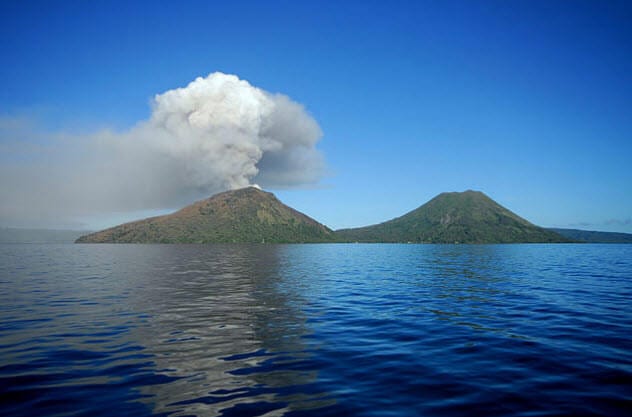
The Late Antique Little Ice Age began in what are called the extreme weather events of AD 535–536. Those two years were the coolest of the last 2,000 years and left a trail of unseasonable weather, crop failures, and famines worldwide.
The events are attributed to either a volcanic eruption or to a bolide impact with the Earth, creating a veil of dust around the planet that the Sun could not get through. Volcanism is by far the most likely candidate as it corresponds with other such “volcanic winter” scenarios we have seen previously.
The evidence is collected from many sources, including the Byzantine historian Procopius. He wrote, “During this year, a most dread portent took place. For the Sun gave forth its light without brightness . . . and it seemed exceedingly like the Sun in eclipse, for the beams it shed were not clear.”
It is also mentioned in several Irish annals. Other sources recorded snow in summer in China, dense fogs over Europe and Asia, and a drought in Peru, which influenced the Moche culture. A spate of volcanic eruptions in AD 535, 540, and 547 at the Rabaul caldera, Krakatoa, and Ilopango caldera in central El Salvador are the likely culprits for these events and the cataclysmic changes around this period of time. However, there were also other large volcanic events in North America at this time.[9]
The following decades saw some of the largest changes in human history, attributed in part to the events described above. Many cultures suffered due to the long-lasting effects of this dust and haze in the atmosphere.
The dates correspond to the late Migration Period of the Scandinavians as well as the decline and fall of Teotihuacan, a massive city-state in Mesoamerica where droughts from the climate changes provoked civil unrest and famines. The Plague of Justinian is attributed to the lasting effects of this event as is the decline of the Avars, the fall of the Gupta and Sassanid Empires, the westward migration of the Mongolian tribes, and the expansion of Turkic tribes.
But perhaps the biggest world-changing event that can be linked to these cataclysms is the rise of Islam. In the continued chaos from the various plagues, empires collapsed and reemerged. Islam and Muhammad, the religion’s prophet, prospered as the areas were relatively free of strong military force. The region was still recovering from the previous chaos, which provided a relatively safe area in which to nurture this new belief.
Not everyone agrees with the above, and there are many questions to be answered. But the concept is sound given the political and military vacuum created by this period in Earth’s history. It was discussed in depth in Catastrophe! How the World Changed, the WNET and Channel Four documentary that was based on a book by David Keys.
1 The Lisbon Earthquake And The Age Of Enlightenment
1755
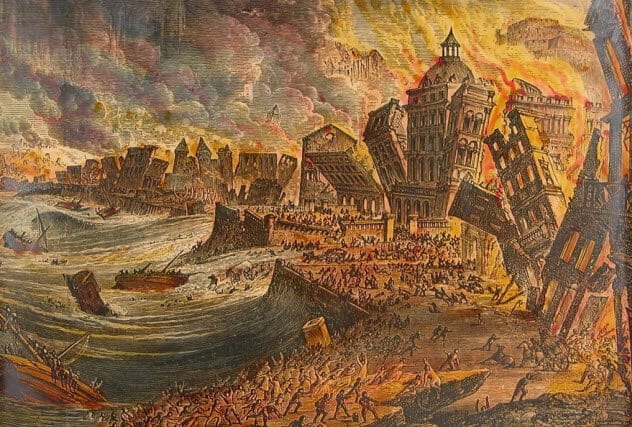
The Lisbon earthquake and tsunami was one of the largest earthquakes the modern era has seen, with a possible magnitude of 9 on the moment magnitude scale. This would be equivalent to the Indian Ocean earthquake and tsunami of 2004.
The 1755 earthquake virtually destroyed Lisbon, with as many as 100,000 people killed. Massive fissures up to 5 meters (16 ft) wide opened in the city. Survivors hurried to the port area, which was relatively open and unscathed, only to be met with a 30-meter-high (100 ft) tsunami.
The earthquake was felt as far away as Greenland, Finland, the Caribbean, and North Africa. Tsunamis 20 meters (66 ft) high hit North Africa, inundating Barbados and Martinique. A 3-meter (10 ft) wave reached as far as Cornwall in the UK.
The cultural effect of this earthquake has had repercussions and ramifications throughout the following centuries. It was the precursor to the intelligentsia of the era discussing the fundamental understanding of our world and knowledge. The Age of Enlightenment is directly linked to the events on November 1, 1755, which was the celebration of All Saints’ Day, as the disaster destroyed nearly every religious building and church throughout Lisbon and, more importantly, Portugal.[10]
This caused mass confusion about how a God so venerated in the staunchly Roman Catholic country could be so vengeful. It led to the great philosophers debating this idea with theologians. The earthquake also had a disastrous effect on Portugal’s economy. At a stroke, it took away their power as a seafaring empire, costing the country approximately 45 percent of its GDP.
Voltaire used a poem, “Poeme sur le desastre de Lisbonne,” and various parts of Candide to attack the then-current philosophy of “God knows best” in which people were not to question His authority. This defiance set the stage for the overthrow of blind religious indoctrination and a move toward a more logical questioning of why we observe what we do. It set the stage for the scientific method to take over, providing evidence for our physical reality.
Immanuel Kant, Jean-Jacques Rousseau, and many others took inspiration from the earthquake and led us to our cultural, political, ideological, and industrial revolutions in Europe. It was also one of the most significant points in the study of seismology and why the Earth reacts the way it does.
This reasoning became the primary source of authority and legitimacy. It came to advance ideals like liberty, progress, tolerance, fraternity, constitutional government, and the separation of church and state.
The phrase Sapere aude, “Dare to know,” delivered our current knowledge. Our intellectual and philosophical ideas based on reason are a direct and indirect result of this massive earthquake, which shifted our culture seismically as much as it shifted Lisbon.
Read more about the surprising consequences of natural disasters on 10 Devastating Natural Disasters Forgotten By Time and 10 Natural Disasters That Created A More Beautiful World.



